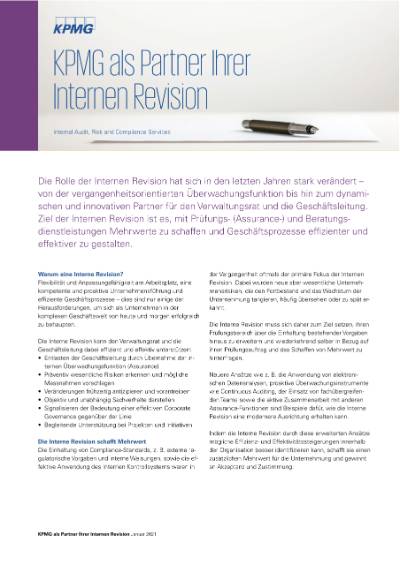KPMG’s Angebote im Bereich Interne Revision, Risiko- und Compliance-Management Systeme (IARCS) zielen darauf ab, die Interne Revisions-, Risiko- und Compliance-Funktionen bedarfsgerecht auszugestalten, unabhängig die Schlüsselrisiken der Unternehmung zu prüfen sowie die Effizienz und Effektivität der Kontrollrahmenwerke nachhaltig sicherzustellen und damit den Anforderungen der verschiedenen Anspruchsgruppen gerecht zu werden.
Das IARCS-Team setzt dabei auf seine breite Erfahrung in der erfolgreichen Unterstützung von nationalen und internationalen Unternehmen, die Anwendung von praxiserprobten Methodologien und Ansätzen, einem weltweiten Netzwerk an Spezialisten sowie industriespezifischen Benchmarking gegenüber Best-Practice.
KPMG's Expertise im Bereich interne Revision, Risiko- und Compliance-Management Systemen
- Beratung bei der Konzeption, Einführung und Transformation von Internen Revisionsfunktionen
- Führen von Internen Revisionsfunktionen im Co- und Out-Sourcing Auftragsverhältnis
- Durchführung einer unabhängigen Prüfung der Internen Revisionsfunktion auf der Grundlage der IIA Standards (Quality Review der interne Revision auf Basis der wesentlichen Berufsgrundlagen, z.B. International Professional Practices Framework (IPPF))
- Konzeption, Einführung und Prüfung von Risiko-Management-Systemen (nach ISO31000)
- Beratung bei der Entwicklung, Dokumentation, Transformation und nachhaltigen Ausgestaltung von internen Kontrollsystemen (IKS nach Schweizer Recht sowie SOX auf Basis von COSO2013)
- Entwicklung, Einführung und Prüfung von Compliance Management Systemen (nach IDW980)
- Entwicklung und Einführung einer nachhaltigen Corporate Governance (koordinierte Assurance)
- Durchführen von ISEA3000 Aussurance-Aufträgen
Publikationen & Thought Leadership
Durch sich stetig verändernde geschäftliche und regulatorische Rahmenbedingungen stehen Unternehmen vor neuen Herausforderungen, die traditionelle Strategien und Annahmen in Frage stellen. In diesem Umfeld sind Resilienz, Anpassungsfähigkeit und Schnelligkeit wesentliche Voraussetzungen für das Überleben von Unternehmen.
Wir haben nachfolgend die wichtigsten Artikel und Publikationen zusammengetragen.
Governance der Internen Revision
Chief Audit Executives (CAE) rücken zunehmend ins Blickfeld einer kritischen Prüfung, um potenzielle Herausforderungen im Zusammenhang mit der guten Führung ihrer internen Revisionsfunktionen zu bewältigen. Eine «angemessene» Dauer für die Tätigkeit eines CAE als Leiter der internen Revisionsfunktion wird von immer mehr Leitern von Audit Committees in Frage gestellt. Gleichzeitig haben die vergangenen beiden Jahre, in denen die Herausforderungen durch COVID-19 anstanden, gezeigt, dass die Interne Revision nicht immer richtig aufgestellt ist, um das Unternehmen zu unterstützen.
Fokus der Interne Revision
CAE haben sicherzustellen, dass ihr Assurance-Auftrag Mehrwerte für das Unternehmen und für die für Governance zuständigen Stellen herbeiführt (d. h. Audit Committees). Von daher müssen CAE potenzielle entstehende Risiken, die die wirtschaftliche Entwicklung des Unternehmens möglicherweise stören, frühzeitig erkennen. Gleichzeitig müssen sie sich bewusst machen, was wesentliche Stakeholder erwarten.
Umsetzung der Internen Revision
Die wesentliche Verantwortung eines CAE besteht darin sicherzustellen, dass die Interne Revisionsfunktion produktiv und im Einklang mit den Erwartungen der bedeutenden Stakeholder arbeitet. Angesichts der Herausforderungen durch die Pandemie sind alternative Ansätze entstanden, wie Assurance-bezogene Revisionsaufgaben umzusetzen sind.
Neue Wege für die Revision wie die «mobile» oder «agile» Revision sind entstanden, um den Prozess effizienter und effektiver zu machen. Gleichzeitig wird so den Einschränkungen der von der Revision unterzogenen Stellen in Bezug auf Zeit, Reisen oder Verfügbarkeit Rechnung getragen. Diese drei Positionspapiere erörtern die neuen oder alternativen Revisionsverfahren und wie ein Revisionsbericht zu erstellen ist, damit er Erkenntnisse vermittelt und Auswirkungen auf wesentliche Stakeholder herbeiführt.




